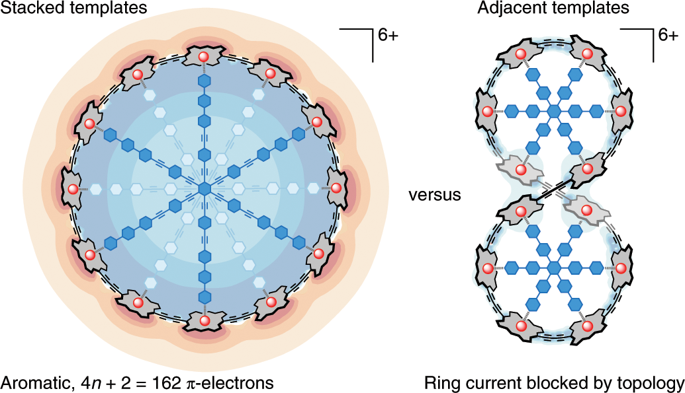Nature Chemistry ( IF 19.2 ) Pub Date : 2020-01-20 , DOI: 10.1038/s41557-019-0398-3 Michel Rickhaus 1, 2 , Michael Jirasek 1 , Lara Tejerina 1 , Henrik Gotfredsen 1 , Martin D Peeks 1, 3 , Renée Haver 1 , Hua-Wei Jiang 1 , Timothy D W Claridge 1 , Harry L Anderson 1

|
Aromaticity can be defined by the ability of a molecule to sustain a ring current when placed in a magnetic field. Hückel’s rule states that molecular rings with [4n + 2] π-electrons are aromatic, with an induced magnetization that opposes the external field inside the ring, whereas those with 4n π-electrons are antiaromatic, with the opposite magnetization. This rule reliably predicts the behaviour of small molecules, typically with fewer than 22 π-electrons (n = 5). It is not clear whether aromaticity has a size limit, or whether Hückel’s rule extends to much larger macrocycles. Here, we present evidence for global aromaticity in porphyrin nanorings with circuits of up to 162 π-electrons (n = 40); aromaticity is controlled by changing the constitution, oxidation state and conformation. Whenever a ring current is observed, its direction is correctly predicted by Hückel’s rule. The largest ring currents occur when the porphyrin units have fractional oxidation states.
中文翻译:

纳米尺度的全球芳香性
芳香性可以通过分子在磁场中维持环电流的能力来定义。Hückel 规则指出,具有 [4 n + 2] π 电子的分子环是芳香的,其感应磁化强度与环内的外场相反,而具有 4 n π 电子的分子环是反芳香的,具有相反的磁化强度。该规则可靠地预测小分子的行为,通常少于 22 个 π 电子 ( n = 5)。目前尚不清楚芳香性是否有大小限制,或者 Hückel 规则是否扩展到更大的大环。在这里,我们提出了具有高达 162 个 π 电子(n = 40); 芳香性是通过改变组成、氧化态和构象来控制的。每当观察到环流时,其方向都可以通过 Hückel 规则正确预测。当卟啉单元具有部分氧化态时,会出现最大的环电流。































 京公网安备 11010802027423号
京公网安备 11010802027423号